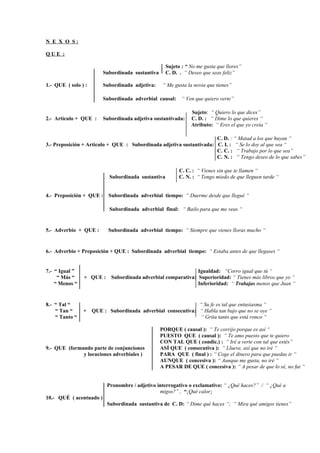Denunciar
Compartir

Recomendados
Más contenido relacionado
Destacado
Destacado (20)
Product Design Trends in 2024 | Teenage Engineerings

Product Design Trends in 2024 | Teenage Engineerings
How Race, Age and Gender Shape Attitudes Towards Mental Health

How Race, Age and Gender Shape Attitudes Towards Mental Health
AI Trends in Creative Operations 2024 by Artwork Flow.pdf

AI Trends in Creative Operations 2024 by Artwork Flow.pdf
Content Methodology: A Best Practices Report (Webinar)

Content Methodology: A Best Practices Report (Webinar)
How to Prepare For a Successful Job Search for 2024

How to Prepare For a Successful Job Search for 2024
Social Media Marketing Trends 2024 // The Global Indie Insights

Social Media Marketing Trends 2024 // The Global Indie Insights
Trends In Paid Search: Navigating The Digital Landscape In 2024

Trends In Paid Search: Navigating The Digital Landscape In 2024
5 Public speaking tips from TED - Visualized summary

5 Public speaking tips from TED - Visualized summary
Google's Just Not That Into You: Understanding Core Updates & Search Intent

Google's Just Not That Into You: Understanding Core Updates & Search Intent
The six step guide to practical project management

The six step guide to practical project management
Beginners Guide to TikTok for Search - Rachel Pearson - We are Tilt __ Bright...

Beginners Guide to TikTok for Search - Rachel Pearson - We are Tilt __ Bright...
S nexos
- 1. N E X O S: QUE : Sujeto : “ No me gusta que llores” Subordinada sustantiva C. D. . “ Deseo que seas feliz” 1.- QUE ( solo ) : Subordinada adjetiva: “ Me gusta la novia que tienes” Subordinada adverbial causal: “ Ven que quiero verte” Sujeto: “ Quiero lo que dices” 2.- Artículo + QUE : Subordinada adjetiva sustantivada: C. D. : “ Dime lo que quieres “ Atributo: “ Eres el que yo creía “ C. D. : “ Matad a los que huyan “ 3.- Preposición + Articulo + QUE : Subordinada adjetiva sustantivada: C. I. : “ Se lo doy al que sea “ C. C. : “ Trabajo por lo que sea” C. N. : “ Tengo deseo de lo que sabes” C. C. : “ Vienes sin que te llamen “ Subordinada sustantiva C. N. : “ Tengo miedo de que lleguen tarde “ 4.- Preposición + QUE : Subordinada adverbial tiempo: “ Duerme desde que llegué “ Subordinada adverbial final: “ Bailo para que me veas “ 5.- Adverbio + QUE : Subordinada adverbial tiempo: “ Siempre que vienes lloras mucho “ 6.- Adverbio + Preposición + QUE : Subordinada adverbial tiempo: “ Estaba antes de que llegases “ 7.- “ Igual ” Igualdad: “Corro igual que tú “ “ Más “ + QUE : Subordinada adverbial comparativa: Superioridad: “ Tienes más libros que yo “ “ Menos “ Inferioridad: “ Trabajas menos que Juan “ 8.- “ Tal “ “ Su fe es tal que entusiasma “ “ Tan “ + QUE : Subordinada adverbial consecutiva: “ Habla tan bajo que no se oye “ “ Tanto “ “ Grita tanto que está ronco “ PORQUE ( causal ): “ Te corrijo porque es así “ PUESTO QUE ( causal ): “ Te amo puesto que te quiero CON TAL QUE ( condic.) : “ Iré a verte con tal que estés” 9.- QUE (formando parte de conjunciones ASÍ QUE ( consecutiva ): “ Llueve, así que no iré “ y locuciones adverbiales ) PARA QUE ( final ) : “ Coge el dinero para que puedas ir “ AUNQUE ( concesiva ): “ Aunque me gusta, no iré “ A PESAR DE QUE ( concesiva ): “ A pesar de que lo sé, no fui “ Pronombre / adjetivo interrogativo o exclamativo: “ ¿Qué haces?” / “ ¿Qué a migos?” , “¡Qué calor¡ 10.- QUÉ ( acentuado ) Subordinada sustantiva de C. D: “ Dime qué haces “; “ Mira qué amigos tienes”
- 2. Interrogativa directa: ( orac. Simple ): ¿Dónde van ahora? Interrogativa indirecta ( subord. sustantiva ): Mira a ver dónde van ahora. DONDE Subordinada adjetiva ( con antecedente ): Vimos el lugar donde ocurrieron los hechos. ( adverbio ) Subordinada adverbial lugar: Se pusieron en donde no los veía nadie. *Interrogativa directa ( orac. Simple ): ¿Cómo lo has hecho? *Interrogativa indirecta ( subord. sustantiva): Explícame cómo lo has hecho *Subordinada adjetiva ( con antecedente ): Esa es la forma como hay que hacerlo COMO *Subordinada adverbial modal: Lo hice como me dijeron ( *adverbio y Subordinada adverbial causal: Como es muy alegre, da gusto estar con él.c conjunción ) Subordinada adverbial comparativa: Ana no tiene tanta imaginación como su hermana. Subordinada adverbial condicional: Como no me escuchéis me voy. *Interrogativa directa ( oración simple ): ¿Cuándo te vas de vacaciones? *Interrogativa indirecta (subord. sustantiva): No sé cuando podré irme CUANDO *Subordinada adjetiva: Fue aquel año cuando me matriculé en Derecho ( * adverbio y Subordinada adverbial temporal: Cuando abres la ventana, entra frío. conjunción ) Subordinada adverbial condicional: No habrá ninguna novedad, cuando no nos avisan. Coordinada adversativa ( = “pero”) : Los despidieron hace un año, aunque volvieron. AUNQUE ( conjunción ) Subordinada adverbial concesiva: Aunque le pusieron inconvenientes, no se desanimó. Subordinada sustantiva: Averigua si ese es el teléfono de Enrique SI Subordinada adverbial condicional: Si te asomas al balcón, podrás verme. ( conjunción) Subordinada adverbial concesiva: Si Marta es lista, no te imaginas cómo es Irene. Subordinada adverbial causal: La foto salió mal por haberla hecho sin luz POR ( preposición) Subordinada adverbial final: Se marchó de allí por no cruzarse con Elena.
